HA82854: Business and Environment - Organisational Structure Report
VerifiedAdded on 2020/11/30
|14
|5898
|75
Report
AI Summary
This report analyzes the business and its environment, focusing on organizational structures, functions, and external factors. It begins by defining different types of organizations (micro, small, medium, and large businesses) and their characteristics. It then explores various organizational forms, including sole traders, partnerships, limited liability companies (Ltd and plc), and cooperatives. The report examines the relationship between organizational functions (HR, R&D, marketing, finance, etc.) and how they contribute to organizational objectives and structure. It includes an analysis of the advantages and disadvantages of these interrelationships. The PESTLE model is applied to assess the macro-environment of the Samaritans, followed by an examination of the impact of micro and macro factors on business objectives and decision-making. A SWOT analysis for the Samaritans is presented, highlighting the interrelation of strengths and weaknesses with external macro factors. The report concludes with a summary of the key findings and recommendations. The report showcases how different factors can influence the success of a business and its strategic decisions.
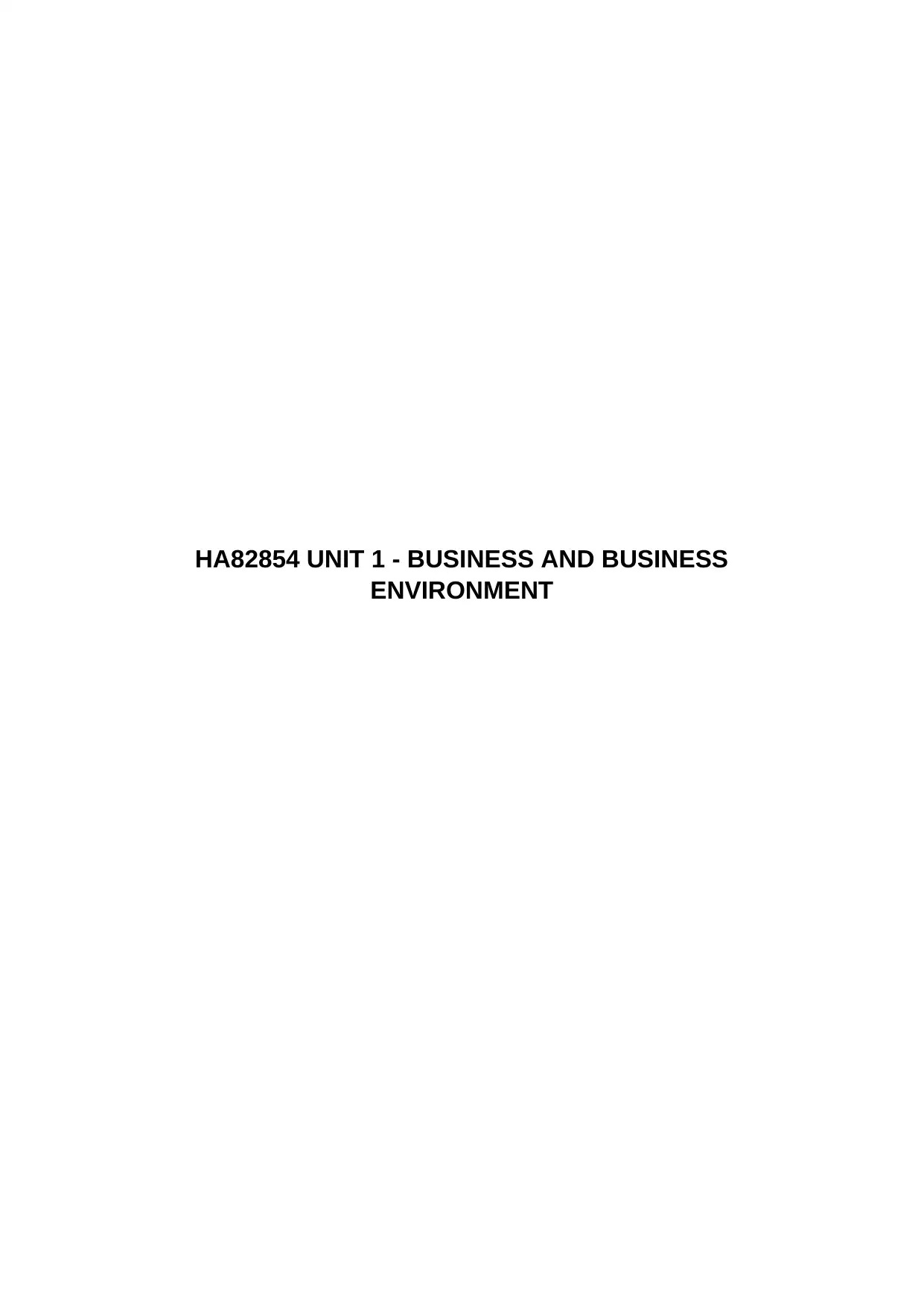
HA82854 UNIT 1 - BUSINESS AND BUSINESS
ENVIRONMENT
ENVIRONMENT
Paraphrase This Document
Need a fresh take? Get an instant paraphrase of this document with our AI Paraphraser
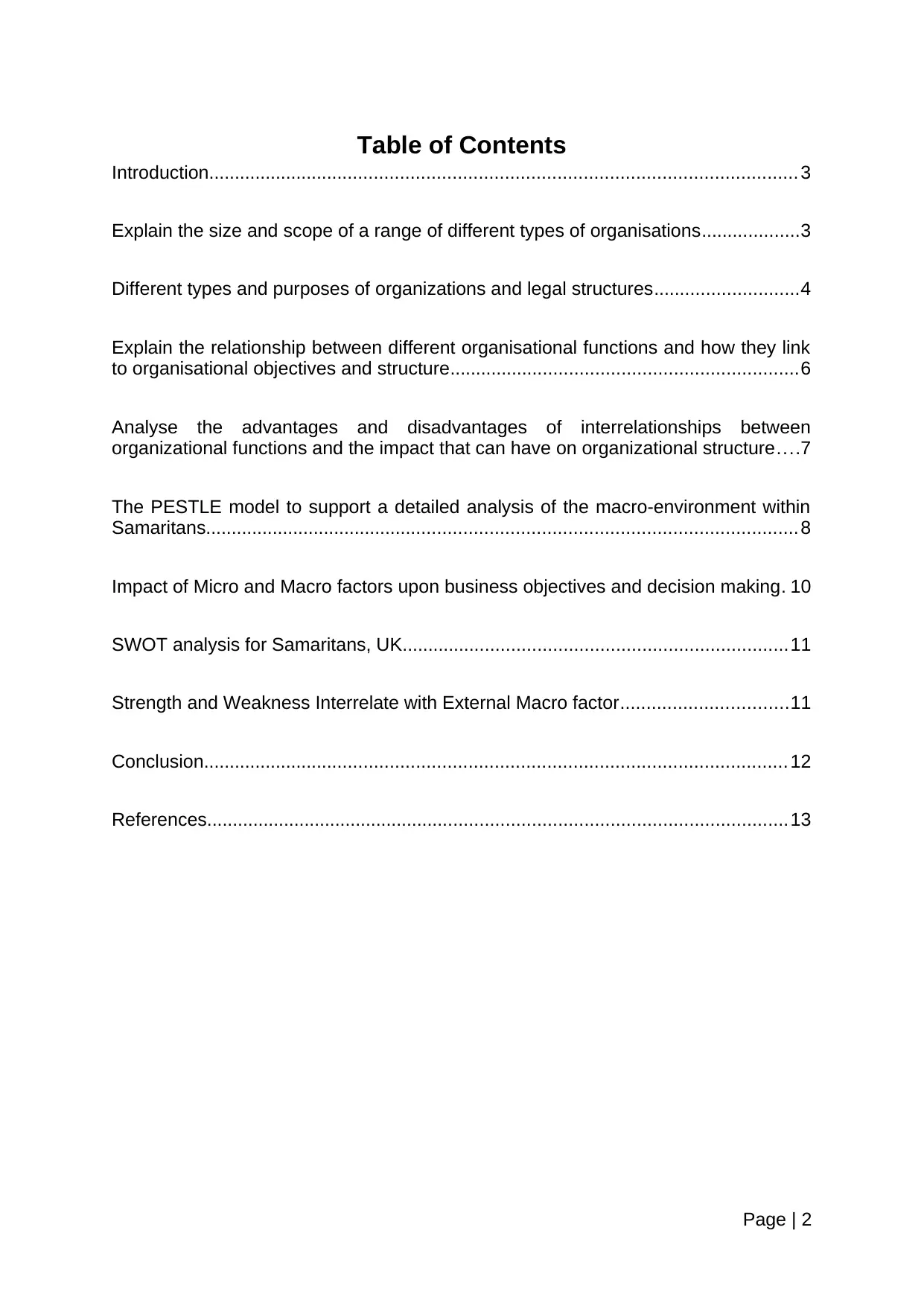
Table of Contents
Introduction................................................................................................................. 3
Explain the size and scope of a range of different types of organisations...................3
Different types and purposes of organizations and legal structures............................4
Explain the relationship between different organisational functions and how they link
to organisational objectives and structure...................................................................6
Analyse the advantages and disadvantages of interrelationships between
organizational functions and the impact that can have on organizational structure....7
The PESTLE model to support a detailed analysis of the macro-environment within
Samaritans.................................................................................................................. 8
Impact of Micro and Macro factors upon business objectives and decision making. 10
SWOT analysis for Samaritans, UK..........................................................................11
Strength and Weakness Interrelate with External Macro factor................................11
Conclusion................................................................................................................ 12
References................................................................................................................13
Page | 2
Introduction................................................................................................................. 3
Explain the size and scope of a range of different types of organisations...................3
Different types and purposes of organizations and legal structures............................4
Explain the relationship between different organisational functions and how they link
to organisational objectives and structure...................................................................6
Analyse the advantages and disadvantages of interrelationships between
organizational functions and the impact that can have on organizational structure....7
The PESTLE model to support a detailed analysis of the macro-environment within
Samaritans.................................................................................................................. 8
Impact of Micro and Macro factors upon business objectives and decision making. 10
SWOT analysis for Samaritans, UK..........................................................................11
Strength and Weakness Interrelate with External Macro factor................................11
Conclusion................................................................................................................ 12
References................................................................................................................13
Page | 2
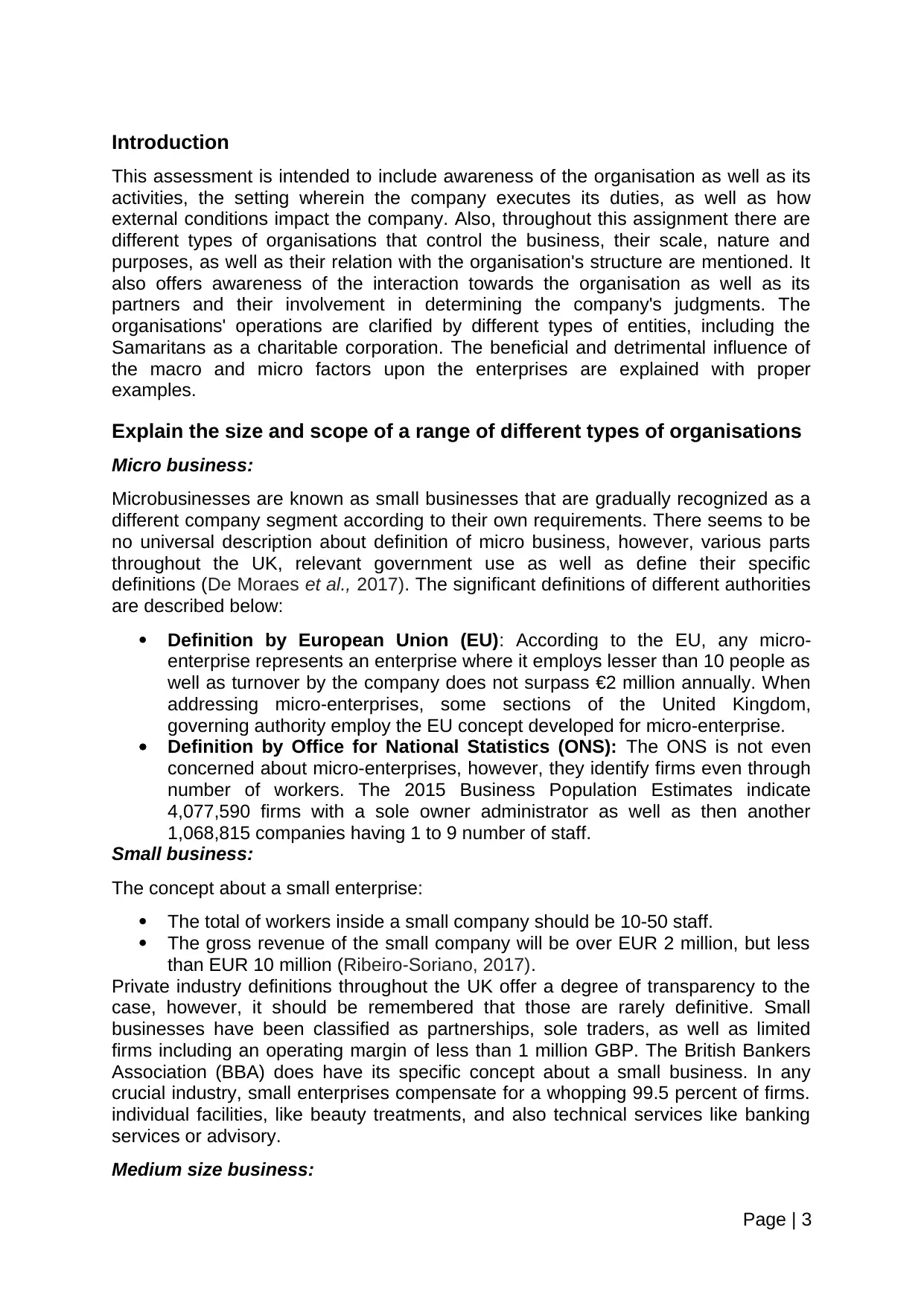
Introduction
This assessment is intended to include awareness of the organisation as well as its
activities, the setting wherein the company executes its duties, as well as how
external conditions impact the company. Also, throughout this assignment there are
different types of organisations that control the business, their scale, nature and
purposes, as well as their relation with the organisation's structure are mentioned. It
also offers awareness of the interaction towards the organisation as well as its
partners and their involvement in determining the company's judgments. The
organisations' operations are clarified by different types of entities, including the
Samaritans as a charitable corporation. The beneficial and detrimental influence of
the macro and micro factors upon the enterprises are explained with proper
examples.
Explain the size and scope of a range of different types of organisations
Micro business:
Microbusinesses are known as small businesses that are gradually recognized as a
different company segment according to their own requirements. There seems to be
no universal description about definition of micro business, however, various parts
throughout the UK, relevant government use as well as define their specific
definitions (De Moraes et al., 2017). The significant definitions of different authorities
are described below:
Definition by European Union (EU): According to the EU, any micro-
enterprise represents an enterprise where it employs lesser than 10 people as
well as turnover by the company does not surpass €2 million annually. When
addressing micro-enterprises, some sections of the United Kingdom,
governing authority employ the EU concept developed for micro-enterprise.
Definition by Office for National Statistics (ONS): The ONS is not even
concerned about micro-enterprises, however, they identify firms even through
number of workers. The 2015 Business Population Estimates indicate
4,077,590 firms with a sole owner administrator as well as then another
1,068,815 companies having 1 to 9 number of staff.
Small business:
The concept about a small enterprise:
The total of workers inside a small company should be 10-50 staff.
The gross revenue of the small company will be over EUR 2 million, but less
than EUR 10 million (Ribeiro-Soriano, 2017).
Private industry definitions throughout the UK offer a degree of transparency to the
case, however, it should be remembered that those are rarely definitive. Small
businesses have been classified as partnerships, sole traders, as well as limited
firms including an operating margin of less than 1 million GBP. The British Bankers
Association (BBA) does have its specific concept about a small business. In any
crucial industry, small enterprises compensate for a whopping 99.5 percent of firms.
individual facilities, like beauty treatments, and also technical services like banking
services or advisory.
Medium size business:
Page | 3
This assessment is intended to include awareness of the organisation as well as its
activities, the setting wherein the company executes its duties, as well as how
external conditions impact the company. Also, throughout this assignment there are
different types of organisations that control the business, their scale, nature and
purposes, as well as their relation with the organisation's structure are mentioned. It
also offers awareness of the interaction towards the organisation as well as its
partners and their involvement in determining the company's judgments. The
organisations' operations are clarified by different types of entities, including the
Samaritans as a charitable corporation. The beneficial and detrimental influence of
the macro and micro factors upon the enterprises are explained with proper
examples.
Explain the size and scope of a range of different types of organisations
Micro business:
Microbusinesses are known as small businesses that are gradually recognized as a
different company segment according to their own requirements. There seems to be
no universal description about definition of micro business, however, various parts
throughout the UK, relevant government use as well as define their specific
definitions (De Moraes et al., 2017). The significant definitions of different authorities
are described below:
Definition by European Union (EU): According to the EU, any micro-
enterprise represents an enterprise where it employs lesser than 10 people as
well as turnover by the company does not surpass €2 million annually. When
addressing micro-enterprises, some sections of the United Kingdom,
governing authority employ the EU concept developed for micro-enterprise.
Definition by Office for National Statistics (ONS): The ONS is not even
concerned about micro-enterprises, however, they identify firms even through
number of workers. The 2015 Business Population Estimates indicate
4,077,590 firms with a sole owner administrator as well as then another
1,068,815 companies having 1 to 9 number of staff.
Small business:
The concept about a small enterprise:
The total of workers inside a small company should be 10-50 staff.
The gross revenue of the small company will be over EUR 2 million, but less
than EUR 10 million (Ribeiro-Soriano, 2017).
Private industry definitions throughout the UK offer a degree of transparency to the
case, however, it should be remembered that those are rarely definitive. Small
businesses have been classified as partnerships, sole traders, as well as limited
firms including an operating margin of less than 1 million GBP. The British Bankers
Association (BBA) does have its specific concept about a small business. In any
crucial industry, small enterprises compensate for a whopping 99.5 percent of firms.
individual facilities, like beauty treatments, and also technical services like banking
services or advisory.
Medium size business:
Page | 3
⊘ This is a preview!⊘
Do you want full access?
Subscribe today to unlock all pages.

Trusted by 1+ million students worldwide
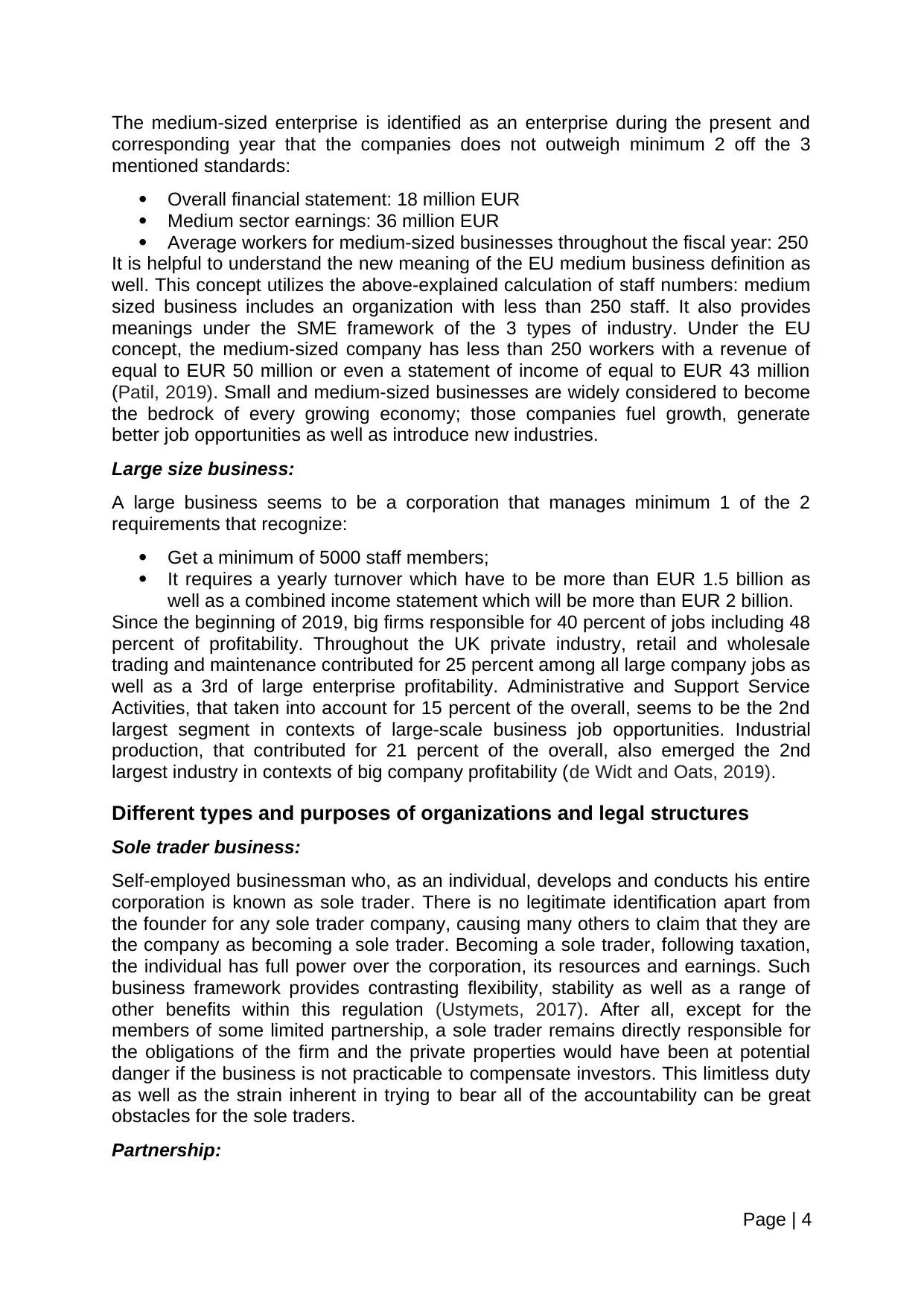
The medium-sized enterprise is identified as an enterprise during the present and
corresponding year that the companies does not outweigh minimum 2 off the 3
mentioned standards:
Overall financial statement: 18 million EUR
Medium sector earnings: 36 million EUR
Average workers for medium-sized businesses throughout the fiscal year: 250
It is helpful to understand the new meaning of the EU medium business definition as
well. This concept utilizes the above-explained calculation of staff numbers: medium
sized business includes an organization with less than 250 staff. It also provides
meanings under the SME framework of the 3 types of industry. Under the EU
concept, the medium-sized company has less than 250 workers with a revenue of
equal to EUR 50 million or even a statement of income of equal to EUR 43 million
(Patil, 2019). Small and medium-sized businesses are widely considered to become
the bedrock of every growing economy; those companies fuel growth, generate
better job opportunities as well as introduce new industries.
Large size business:
A large business seems to be a corporation that manages minimum 1 of the 2
requirements that recognize:
Get a minimum of 5000 staff members;
It requires a yearly turnover which have to be more than EUR 1.5 billion as
well as a combined income statement which will be more than EUR 2 billion.
Since the beginning of 2019, big firms responsible for 40 percent of jobs including 48
percent of profitability. Throughout the UK private industry, retail and wholesale
trading and maintenance contributed for 25 percent among all large company jobs as
well as a 3rd of large enterprise profitability. Administrative and Support Service
Activities, that taken into account for 15 percent of the overall, seems to be the 2nd
largest segment in contexts of large-scale business job opportunities. Industrial
production, that contributed for 21 percent of the overall, also emerged the 2nd
largest industry in contexts of big company profitability (de Widt and Oats, 2019).
Different types and purposes of organizations and legal structures
Sole trader business:
Self-employed businessman who, as an individual, develops and conducts his entire
corporation is known as sole trader. There is no legitimate identification apart from
the founder for any sole trader company, causing many others to claim that they are
the company as becoming a sole trader. Becoming a sole trader, following taxation,
the individual has full power over the corporation, its resources and earnings. Such
business framework provides contrasting flexibility, stability as well as a range of
other benefits within this regulation (Ustymets, 2017). After all, except for the
members of some limited partnership, a sole trader remains directly responsible for
the obligations of the firm and the private properties would have been at potential
danger if the business is not practicable to compensate investors. This limitless duty
as well as the strain inherent in trying to bear all of the accountability can be great
obstacles for the sole traders.
Partnership:
Page | 4
corresponding year that the companies does not outweigh minimum 2 off the 3
mentioned standards:
Overall financial statement: 18 million EUR
Medium sector earnings: 36 million EUR
Average workers for medium-sized businesses throughout the fiscal year: 250
It is helpful to understand the new meaning of the EU medium business definition as
well. This concept utilizes the above-explained calculation of staff numbers: medium
sized business includes an organization with less than 250 staff. It also provides
meanings under the SME framework of the 3 types of industry. Under the EU
concept, the medium-sized company has less than 250 workers with a revenue of
equal to EUR 50 million or even a statement of income of equal to EUR 43 million
(Patil, 2019). Small and medium-sized businesses are widely considered to become
the bedrock of every growing economy; those companies fuel growth, generate
better job opportunities as well as introduce new industries.
Large size business:
A large business seems to be a corporation that manages minimum 1 of the 2
requirements that recognize:
Get a minimum of 5000 staff members;
It requires a yearly turnover which have to be more than EUR 1.5 billion as
well as a combined income statement which will be more than EUR 2 billion.
Since the beginning of 2019, big firms responsible for 40 percent of jobs including 48
percent of profitability. Throughout the UK private industry, retail and wholesale
trading and maintenance contributed for 25 percent among all large company jobs as
well as a 3rd of large enterprise profitability. Administrative and Support Service
Activities, that taken into account for 15 percent of the overall, seems to be the 2nd
largest segment in contexts of large-scale business job opportunities. Industrial
production, that contributed for 21 percent of the overall, also emerged the 2nd
largest industry in contexts of big company profitability (de Widt and Oats, 2019).
Different types and purposes of organizations and legal structures
Sole trader business:
Self-employed businessman who, as an individual, develops and conducts his entire
corporation is known as sole trader. There is no legitimate identification apart from
the founder for any sole trader company, causing many others to claim that they are
the company as becoming a sole trader. Becoming a sole trader, following taxation,
the individual has full power over the corporation, its resources and earnings. Such
business framework provides contrasting flexibility, stability as well as a range of
other benefits within this regulation (Ustymets, 2017). After all, except for the
members of some limited partnership, a sole trader remains directly responsible for
the obligations of the firm and the private properties would have been at potential
danger if the business is not practicable to compensate investors. This limitless duty
as well as the strain inherent in trying to bear all of the accountability can be great
obstacles for the sole traders.
Partnership:
Page | 4
Paraphrase This Document
Need a fresh take? Get an instant paraphrase of this document with our AI Paraphraser
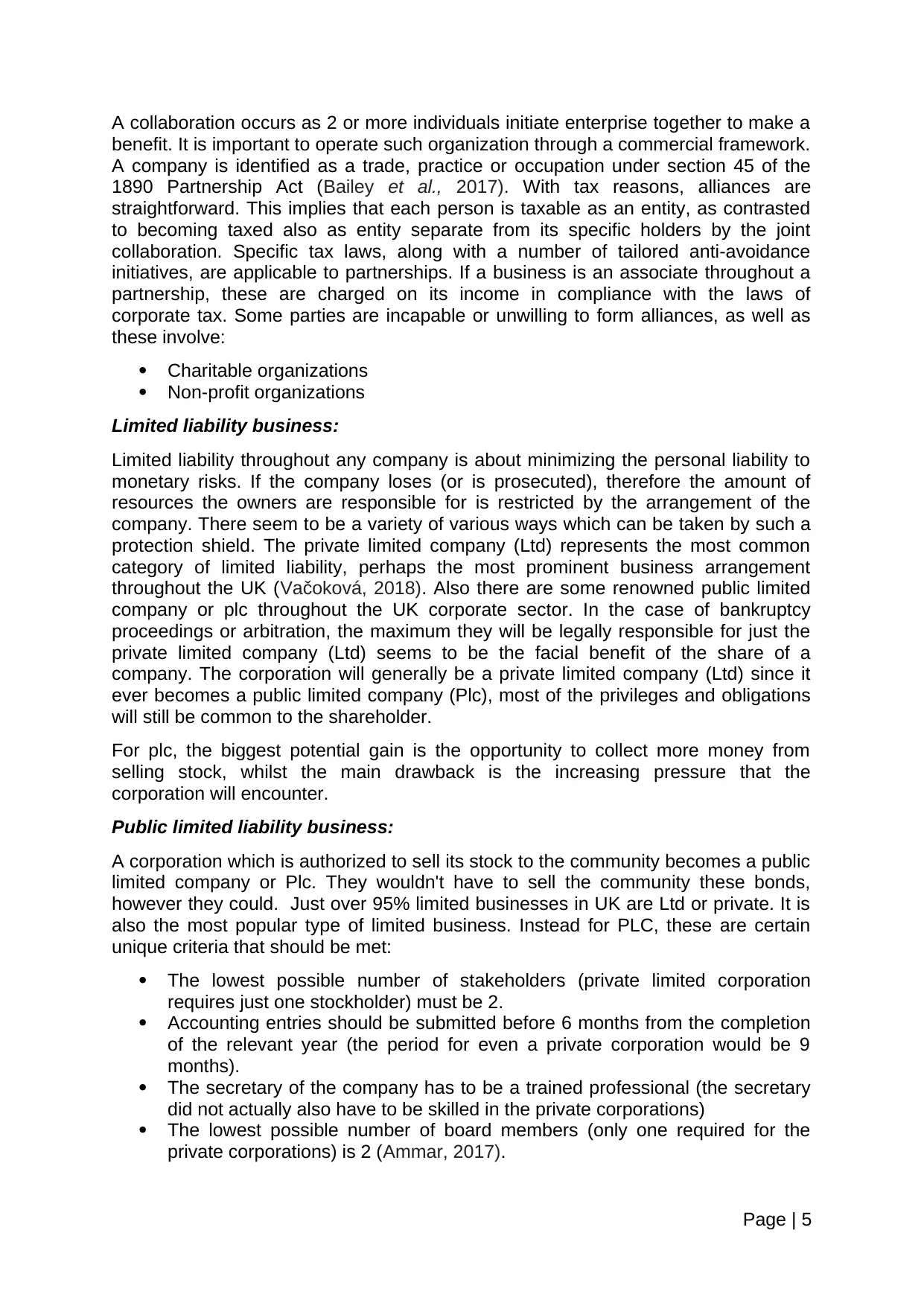
A collaboration occurs as 2 or more individuals initiate enterprise together to make a
benefit. It is important to operate such organization through a commercial framework.
A company is identified as a trade, practice or occupation under section 45 of the
1890 Partnership Act (Bailey et al., 2017). With tax reasons, alliances are
straightforward. This implies that each person is taxable as an entity, as contrasted
to becoming taxed also as entity separate from its specific holders by the joint
collaboration. Specific tax laws, along with a number of tailored anti-avoidance
initiatives, are applicable to partnerships. If a business is an associate throughout a
partnership, these are charged on its income in compliance with the laws of
corporate tax. Some parties are incapable or unwilling to form alliances, as well as
these involve:
Charitable organizations
Non-profit organizations
Limited liability business:
Limited liability throughout any company is about minimizing the personal liability to
monetary risks. If the company loses (or is prosecuted), therefore the amount of
resources the owners are responsible for is restricted by the arrangement of the
company. There seem to be a variety of various ways which can be taken by such a
protection shield. The private limited company (Ltd) represents the most common
category of limited liability, perhaps the most prominent business arrangement
throughout the UK (Vačoková, 2018). Also there are some renowned public limited
company or plc throughout the UK corporate sector. In the case of bankruptcy
proceedings or arbitration, the maximum they will be legally responsible for just the
private limited company (Ltd) seems to be the facial benefit of the share of a
company. The corporation will generally be a private limited company (Ltd) since it
ever becomes a public limited company (Plc), most of the privileges and obligations
will still be common to the shareholder.
For plc, the biggest potential gain is the opportunity to collect more money from
selling stock, whilst the main drawback is the increasing pressure that the
corporation will encounter.
Public limited liability business:
A corporation which is authorized to sell its stock to the community becomes a public
limited company or Plc. They wouldn't have to sell the community these bonds,
however they could. Just over 95% limited businesses in UK are Ltd or private. It is
also the most popular type of limited business. Instead for PLC, these are certain
unique criteria that should be met:
The lowest possible number of stakeholders (private limited corporation
requires just one stockholder) must be 2.
Accounting entries should be submitted before 6 months from the completion
of the relevant year (the period for even a private corporation would be 9
months).
The secretary of the company has to be a trained professional (the secretary
did not actually also have to be skilled in the private corporations)
The lowest possible number of board members (only one required for the
private corporations) is 2 (Ammar, 2017).
Page | 5
benefit. It is important to operate such organization through a commercial framework.
A company is identified as a trade, practice or occupation under section 45 of the
1890 Partnership Act (Bailey et al., 2017). With tax reasons, alliances are
straightforward. This implies that each person is taxable as an entity, as contrasted
to becoming taxed also as entity separate from its specific holders by the joint
collaboration. Specific tax laws, along with a number of tailored anti-avoidance
initiatives, are applicable to partnerships. If a business is an associate throughout a
partnership, these are charged on its income in compliance with the laws of
corporate tax. Some parties are incapable or unwilling to form alliances, as well as
these involve:
Charitable organizations
Non-profit organizations
Limited liability business:
Limited liability throughout any company is about minimizing the personal liability to
monetary risks. If the company loses (or is prosecuted), therefore the amount of
resources the owners are responsible for is restricted by the arrangement of the
company. There seem to be a variety of various ways which can be taken by such a
protection shield. The private limited company (Ltd) represents the most common
category of limited liability, perhaps the most prominent business arrangement
throughout the UK (Vačoková, 2018). Also there are some renowned public limited
company or plc throughout the UK corporate sector. In the case of bankruptcy
proceedings or arbitration, the maximum they will be legally responsible for just the
private limited company (Ltd) seems to be the facial benefit of the share of a
company. The corporation will generally be a private limited company (Ltd) since it
ever becomes a public limited company (Plc), most of the privileges and obligations
will still be common to the shareholder.
For plc, the biggest potential gain is the opportunity to collect more money from
selling stock, whilst the main drawback is the increasing pressure that the
corporation will encounter.
Public limited liability business:
A corporation which is authorized to sell its stock to the community becomes a public
limited company or Plc. They wouldn't have to sell the community these bonds,
however they could. Just over 95% limited businesses in UK are Ltd or private. It is
also the most popular type of limited business. Instead for PLC, these are certain
unique criteria that should be met:
The lowest possible number of stakeholders (private limited corporation
requires just one stockholder) must be 2.
Accounting entries should be submitted before 6 months from the completion
of the relevant year (the period for even a private corporation would be 9
months).
The secretary of the company has to be a trained professional (the secretary
did not actually also have to be skilled in the private corporations)
The lowest possible number of board members (only one required for the
private corporations) is 2 (Ammar, 2017).
Page | 5
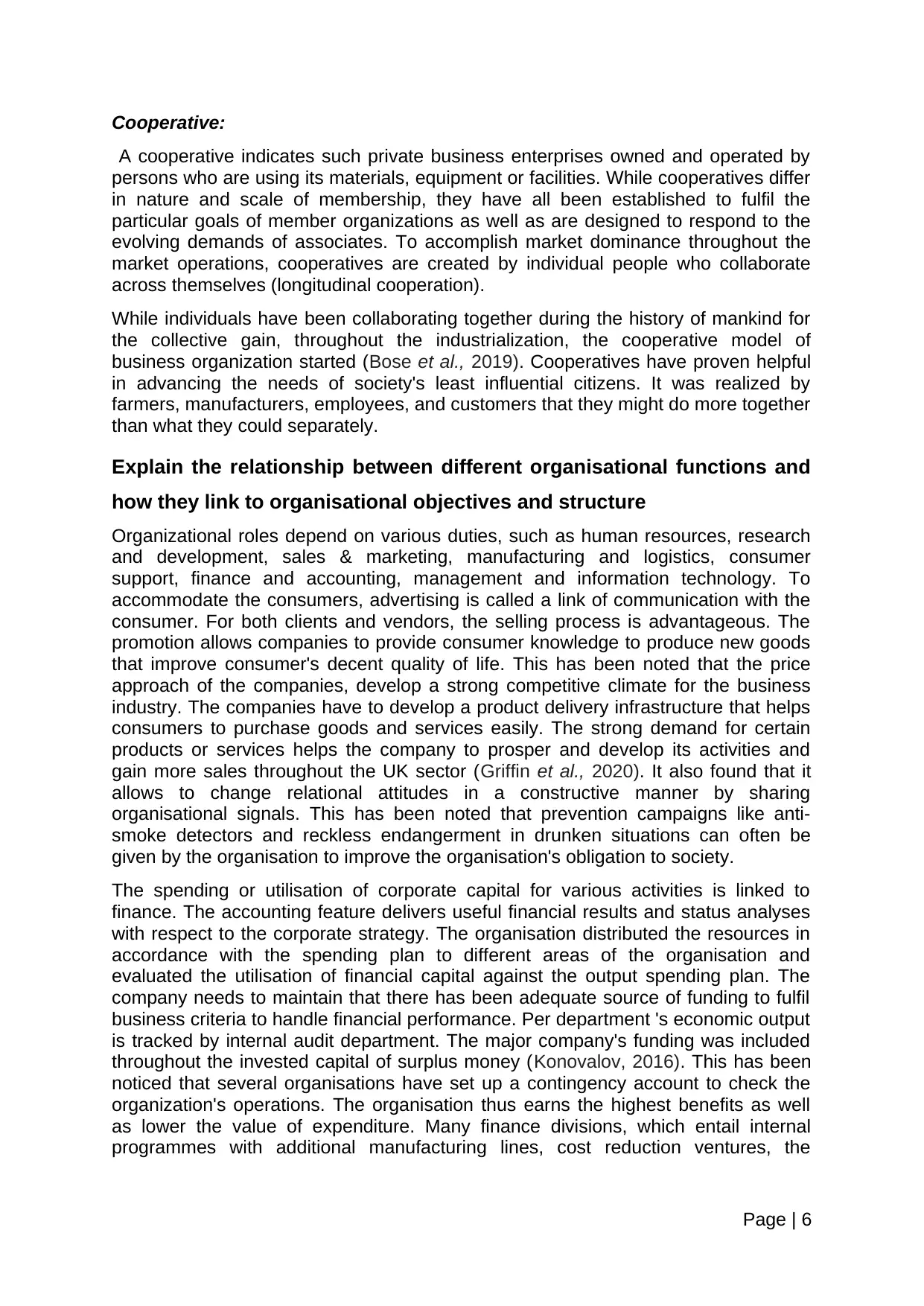
Cooperative:
A cooperative indicates such private business enterprises owned and operated by
persons who are using its materials, equipment or facilities. While cooperatives differ
in nature and scale of membership, they have all been established to fulfil the
particular goals of member organizations as well as are designed to respond to the
evolving demands of associates. To accomplish market dominance throughout the
market operations, cooperatives are created by individual people who collaborate
across themselves (longitudinal cooperation).
While individuals have been collaborating together during the history of mankind for
the collective gain, throughout the industrialization, the cooperative model of
business organization started (Bose et al., 2019). Cooperatives have proven helpful
in advancing the needs of society's least influential citizens. It was realized by
farmers, manufacturers, employees, and customers that they might do more together
than what they could separately.
Explain the relationship between different organisational functions and
how they link to organisational objectives and structure
Organizational roles depend on various duties, such as human resources, research
and development, sales & marketing, manufacturing and logistics, consumer
support, finance and accounting, management and information technology. To
accommodate the consumers, advertising is called a link of communication with the
consumer. For both clients and vendors, the selling process is advantageous. The
promotion allows companies to provide consumer knowledge to produce new goods
that improve consumer's decent quality of life. This has been noted that the price
approach of the companies, develop a strong competitive climate for the business
industry. The companies have to develop a product delivery infrastructure that helps
consumers to purchase goods and services easily. The strong demand for certain
products or services helps the company to prosper and develop its activities and
gain more sales throughout the UK sector (Griffin et al., 2020). It also found that it
allows to change relational attitudes in a constructive manner by sharing
organisational signals. This has been noted that prevention campaigns like anti-
smoke detectors and reckless endangerment in drunken situations can often be
given by the organisation to improve the organisation's obligation to society.
The spending or utilisation of corporate capital for various activities is linked to
finance. The accounting feature delivers useful financial results and status analyses
with respect to the corporate strategy. The organisation distributed the resources in
accordance with the spending plan to different areas of the organisation and
evaluated the utilisation of financial capital against the output spending plan. The
company needs to maintain that there has been adequate source of funding to fulfil
business criteria to handle financial performance. Per department 's economic output
is tracked by internal audit department. The major company's funding was included
throughout the invested capital of surplus money (Konovalov, 2016). This has been
noticed that several organisations have set up a contingency account to check the
organization's operations. The organisation thus earns the highest benefits as well
as lower the value of expenditure. Many finance divisions, which entail internal
programmes with additional manufacturing lines, cost reduction ventures, the
Page | 6
A cooperative indicates such private business enterprises owned and operated by
persons who are using its materials, equipment or facilities. While cooperatives differ
in nature and scale of membership, they have all been established to fulfil the
particular goals of member organizations as well as are designed to respond to the
evolving demands of associates. To accomplish market dominance throughout the
market operations, cooperatives are created by individual people who collaborate
across themselves (longitudinal cooperation).
While individuals have been collaborating together during the history of mankind for
the collective gain, throughout the industrialization, the cooperative model of
business organization started (Bose et al., 2019). Cooperatives have proven helpful
in advancing the needs of society's least influential citizens. It was realized by
farmers, manufacturers, employees, and customers that they might do more together
than what they could separately.
Explain the relationship between different organisational functions and
how they link to organisational objectives and structure
Organizational roles depend on various duties, such as human resources, research
and development, sales & marketing, manufacturing and logistics, consumer
support, finance and accounting, management and information technology. To
accommodate the consumers, advertising is called a link of communication with the
consumer. For both clients and vendors, the selling process is advantageous. The
promotion allows companies to provide consumer knowledge to produce new goods
that improve consumer's decent quality of life. This has been noted that the price
approach of the companies, develop a strong competitive climate for the business
industry. The companies have to develop a product delivery infrastructure that helps
consumers to purchase goods and services easily. The strong demand for certain
products or services helps the company to prosper and develop its activities and
gain more sales throughout the UK sector (Griffin et al., 2020). It also found that it
allows to change relational attitudes in a constructive manner by sharing
organisational signals. This has been noted that prevention campaigns like anti-
smoke detectors and reckless endangerment in drunken situations can often be
given by the organisation to improve the organisation's obligation to society.
The spending or utilisation of corporate capital for various activities is linked to
finance. The accounting feature delivers useful financial results and status analyses
with respect to the corporate strategy. The organisation distributed the resources in
accordance with the spending plan to different areas of the organisation and
evaluated the utilisation of financial capital against the output spending plan. The
company needs to maintain that there has been adequate source of funding to fulfil
business criteria to handle financial performance. Per department 's economic output
is tracked by internal audit department. The major company's funding was included
throughout the invested capital of surplus money (Konovalov, 2016). This has been
noticed that several organisations have set up a contingency account to check the
organization's operations. The organisation thus earns the highest benefits as well
as lower the value of expenditure. Many finance divisions, which entail internal
programmes with additional manufacturing lines, cost reduction ventures, the
Page | 6
⊘ This is a preview!⊘
Do you want full access?
Subscribe today to unlock all pages.

Trusted by 1+ million students worldwide
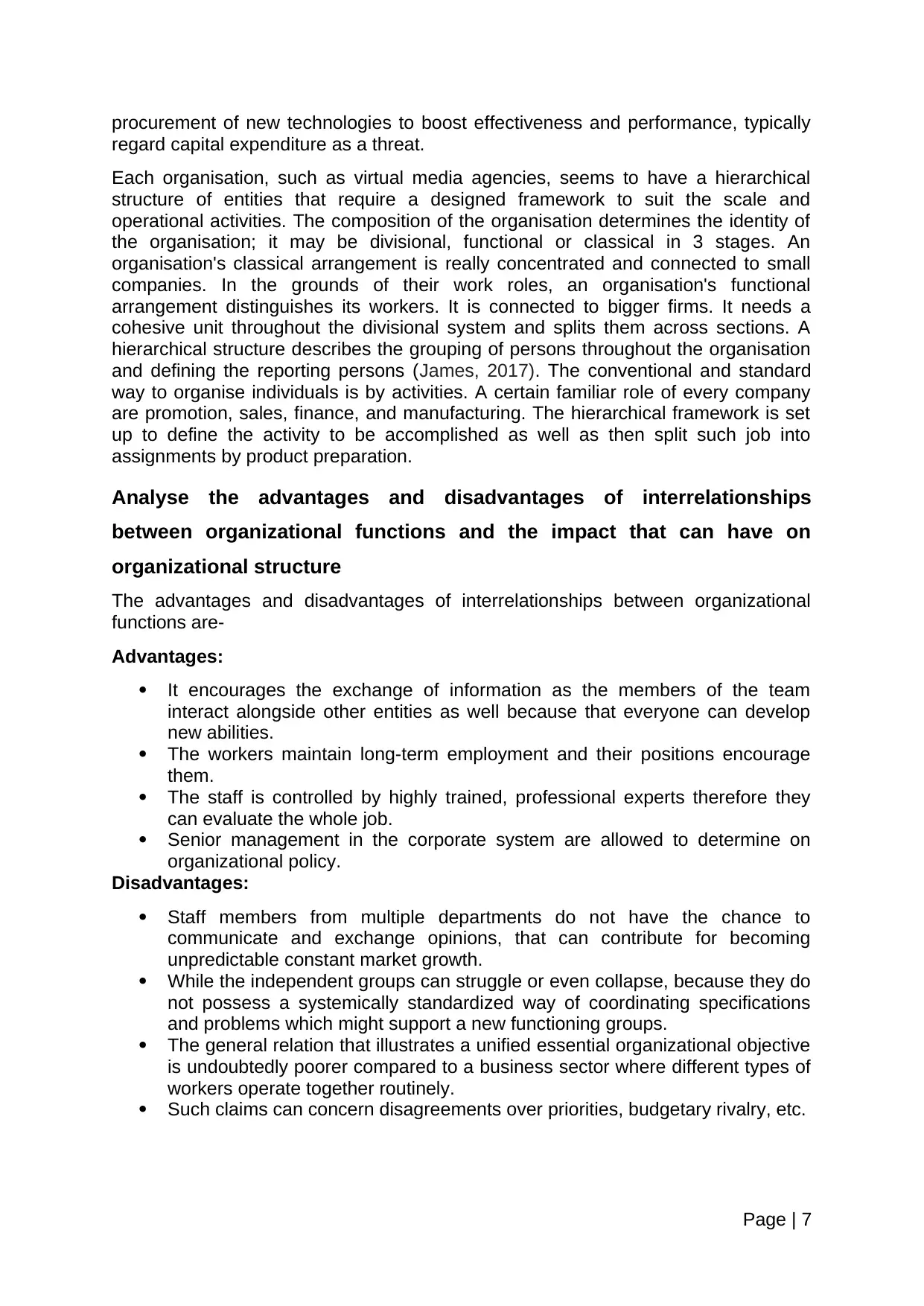
procurement of new technologies to boost effectiveness and performance, typically
regard capital expenditure as a threat.
Each organisation, such as virtual media agencies, seems to have a hierarchical
structure of entities that require a designed framework to suit the scale and
operational activities. The composition of the organisation determines the identity of
the organisation; it may be divisional, functional or classical in 3 stages. An
organisation's classical arrangement is really concentrated and connected to small
companies. In the grounds of their work roles, an organisation's functional
arrangement distinguishes its workers. It is connected to bigger firms. It needs a
cohesive unit throughout the divisional system and splits them across sections. A
hierarchical structure describes the grouping of persons throughout the organisation
and defining the reporting persons (James, 2017). The conventional and standard
way to organise individuals is by activities. A certain familiar role of every company
are promotion, sales, finance, and manufacturing. The hierarchical framework is set
up to define the activity to be accomplished as well as then split such job into
assignments by product preparation.
Analyse the advantages and disadvantages of interrelationships
between organizational functions and the impact that can have on
organizational structure
The advantages and disadvantages of interrelationships between organizational
functions are-
Advantages:
It encourages the exchange of information as the members of the team
interact alongside other entities as well because that everyone can develop
new abilities.
The workers maintain long-term employment and their positions encourage
them.
The staff is controlled by highly trained, professional experts therefore they
can evaluate the whole job.
Senior management in the corporate system are allowed to determine on
organizational policy.
Disadvantages:
Staff members from multiple departments do not have the chance to
communicate and exchange opinions, that can contribute for becoming
unpredictable constant market growth.
While the independent groups can struggle or even collapse, because they do
not possess a systemically standardized way of coordinating specifications
and problems which might support a new functioning groups.
The general relation that illustrates a unified essential organizational objective
is undoubtedly poorer compared to a business sector where different types of
workers operate together routinely.
Such claims can concern disagreements over priorities, budgetary rivalry, etc.
Page | 7
regard capital expenditure as a threat.
Each organisation, such as virtual media agencies, seems to have a hierarchical
structure of entities that require a designed framework to suit the scale and
operational activities. The composition of the organisation determines the identity of
the organisation; it may be divisional, functional or classical in 3 stages. An
organisation's classical arrangement is really concentrated and connected to small
companies. In the grounds of their work roles, an organisation's functional
arrangement distinguishes its workers. It is connected to bigger firms. It needs a
cohesive unit throughout the divisional system and splits them across sections. A
hierarchical structure describes the grouping of persons throughout the organisation
and defining the reporting persons (James, 2017). The conventional and standard
way to organise individuals is by activities. A certain familiar role of every company
are promotion, sales, finance, and manufacturing. The hierarchical framework is set
up to define the activity to be accomplished as well as then split such job into
assignments by product preparation.
Analyse the advantages and disadvantages of interrelationships
between organizational functions and the impact that can have on
organizational structure
The advantages and disadvantages of interrelationships between organizational
functions are-
Advantages:
It encourages the exchange of information as the members of the team
interact alongside other entities as well because that everyone can develop
new abilities.
The workers maintain long-term employment and their positions encourage
them.
The staff is controlled by highly trained, professional experts therefore they
can evaluate the whole job.
Senior management in the corporate system are allowed to determine on
organizational policy.
Disadvantages:
Staff members from multiple departments do not have the chance to
communicate and exchange opinions, that can contribute for becoming
unpredictable constant market growth.
While the independent groups can struggle or even collapse, because they do
not possess a systemically standardized way of coordinating specifications
and problems which might support a new functioning groups.
The general relation that illustrates a unified essential organizational objective
is undoubtedly poorer compared to a business sector where different types of
workers operate together routinely.
Such claims can concern disagreements over priorities, budgetary rivalry, etc.
Page | 7
Paraphrase This Document
Need a fresh take? Get an instant paraphrase of this document with our AI Paraphraser
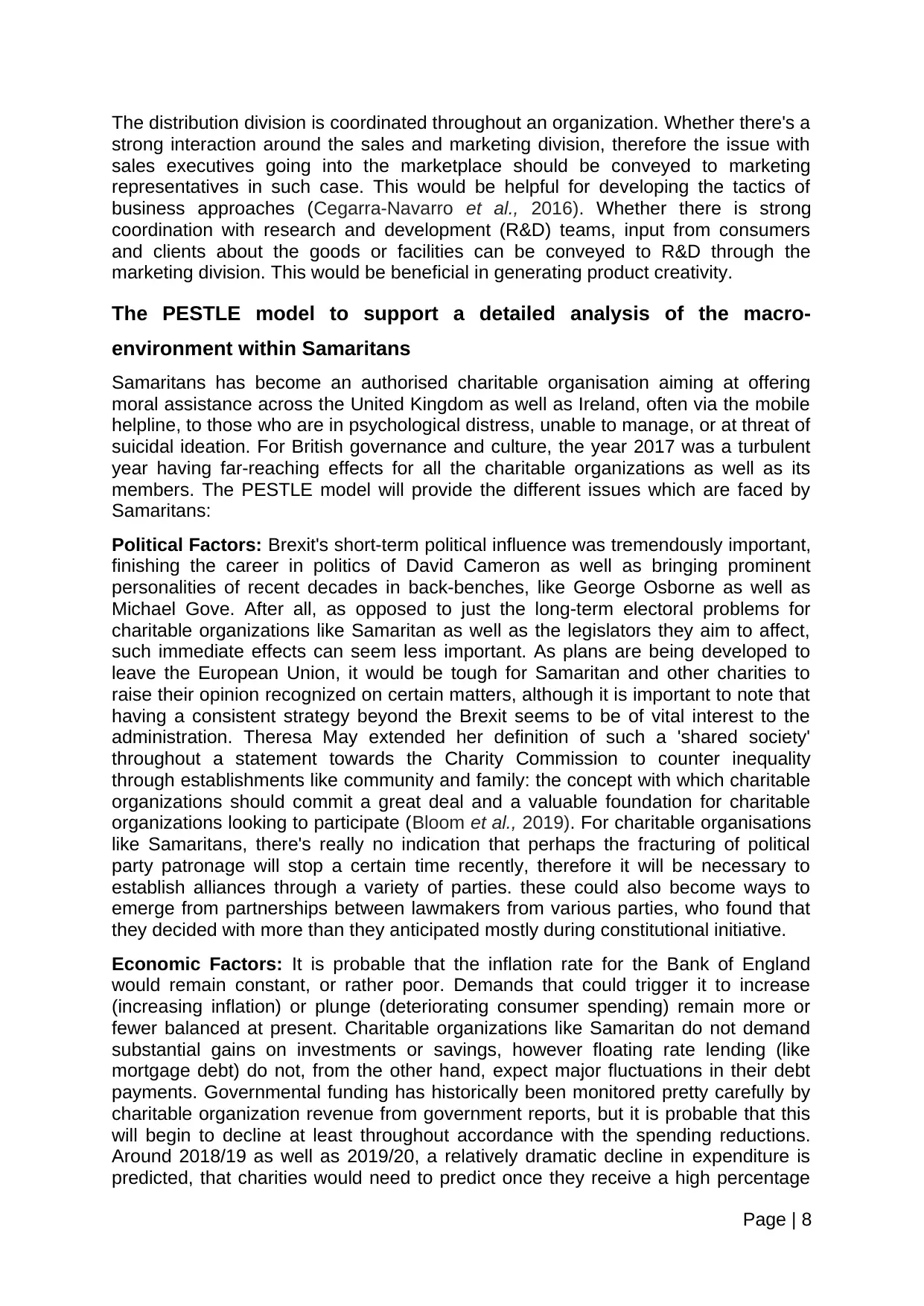
The distribution division is coordinated throughout an organization. Whether there's a
strong interaction around the sales and marketing division, therefore the issue with
sales executives going into the marketplace should be conveyed to marketing
representatives in such case. This would be helpful for developing the tactics of
business approaches (Cegarra-Navarro et al., 2016). Whether there is strong
coordination with research and development (R&D) teams, input from consumers
and clients about the goods or facilities can be conveyed to R&D through the
marketing division. This would be beneficial in generating product creativity.
The PESTLE model to support a detailed analysis of the macro-
environment within Samaritans
Samaritans has become an authorised charitable organisation aiming at offering
moral assistance across the United Kingdom as well as Ireland, often via the mobile
helpline, to those who are in psychological distress, unable to manage, or at threat of
suicidal ideation. For British governance and culture, the year 2017 was a turbulent
year having far-reaching effects for all the charitable organizations as well as its
members. The PESTLE model will provide the different issues which are faced by
Samaritans:
Political Factors: Brexit's short-term political influence was tremendously important,
finishing the career in politics of David Cameron as well as bringing prominent
personalities of recent decades in back-benches, like George Osborne as well as
Michael Gove. After all, as opposed to just the long-term electoral problems for
charitable organizations like Samaritan as well as the legislators they aim to affect,
such immediate effects can seem less important. As plans are being developed to
leave the European Union, it would be tough for Samaritan and other charities to
raise their opinion recognized on certain matters, although it is important to note that
having a consistent strategy beyond the Brexit seems to be of vital interest to the
administration. Theresa May extended her definition of such a 'shared society'
throughout a statement towards the Charity Commission to counter inequality
through establishments like community and family: the concept with which charitable
organizations should commit a great deal and a valuable foundation for charitable
organizations looking to participate (Bloom et al., 2019). For charitable organisations
like Samaritans, there's really no indication that perhaps the fracturing of political
party patronage will stop a certain time recently, therefore it will be necessary to
establish alliances through a variety of parties. these could also become ways to
emerge from partnerships between lawmakers from various parties, who found that
they decided with more than they anticipated mostly during constitutional initiative.
Economic Factors: It is probable that the inflation rate for the Bank of England
would remain constant, or rather poor. Demands that could trigger it to increase
(increasing inflation) or plunge (deteriorating consumer spending) remain more or
fewer balanced at present. Charitable organizations like Samaritan do not demand
substantial gains on investments or savings, however floating rate lending (like
mortgage debt) do not, from the other hand, expect major fluctuations in their debt
payments. Governmental funding has historically been monitored pretty carefully by
charitable organization revenue from government reports, but it is probable that this
will begin to decline at least throughout accordance with the spending reductions.
Around 2018/19 as well as 2019/20, a relatively dramatic decline in expenditure is
predicted, that charities would need to predict once they receive a high percentage
Page | 8
strong interaction around the sales and marketing division, therefore the issue with
sales executives going into the marketplace should be conveyed to marketing
representatives in such case. This would be helpful for developing the tactics of
business approaches (Cegarra-Navarro et al., 2016). Whether there is strong
coordination with research and development (R&D) teams, input from consumers
and clients about the goods or facilities can be conveyed to R&D through the
marketing division. This would be beneficial in generating product creativity.
The PESTLE model to support a detailed analysis of the macro-
environment within Samaritans
Samaritans has become an authorised charitable organisation aiming at offering
moral assistance across the United Kingdom as well as Ireland, often via the mobile
helpline, to those who are in psychological distress, unable to manage, or at threat of
suicidal ideation. For British governance and culture, the year 2017 was a turbulent
year having far-reaching effects for all the charitable organizations as well as its
members. The PESTLE model will provide the different issues which are faced by
Samaritans:
Political Factors: Brexit's short-term political influence was tremendously important,
finishing the career in politics of David Cameron as well as bringing prominent
personalities of recent decades in back-benches, like George Osborne as well as
Michael Gove. After all, as opposed to just the long-term electoral problems for
charitable organizations like Samaritan as well as the legislators they aim to affect,
such immediate effects can seem less important. As plans are being developed to
leave the European Union, it would be tough for Samaritan and other charities to
raise their opinion recognized on certain matters, although it is important to note that
having a consistent strategy beyond the Brexit seems to be of vital interest to the
administration. Theresa May extended her definition of such a 'shared society'
throughout a statement towards the Charity Commission to counter inequality
through establishments like community and family: the concept with which charitable
organizations should commit a great deal and a valuable foundation for charitable
organizations looking to participate (Bloom et al., 2019). For charitable organisations
like Samaritans, there's really no indication that perhaps the fracturing of political
party patronage will stop a certain time recently, therefore it will be necessary to
establish alliances through a variety of parties. these could also become ways to
emerge from partnerships between lawmakers from various parties, who found that
they decided with more than they anticipated mostly during constitutional initiative.
Economic Factors: It is probable that the inflation rate for the Bank of England
would remain constant, or rather poor. Demands that could trigger it to increase
(increasing inflation) or plunge (deteriorating consumer spending) remain more or
fewer balanced at present. Charitable organizations like Samaritan do not demand
substantial gains on investments or savings, however floating rate lending (like
mortgage debt) do not, from the other hand, expect major fluctuations in their debt
payments. Governmental funding has historically been monitored pretty carefully by
charitable organization revenue from government reports, but it is probable that this
will begin to decline at least throughout accordance with the spending reductions.
Around 2018/19 as well as 2019/20, a relatively dramatic decline in expenditure is
predicted, that charities would need to predict once they receive a high percentage
Page | 8
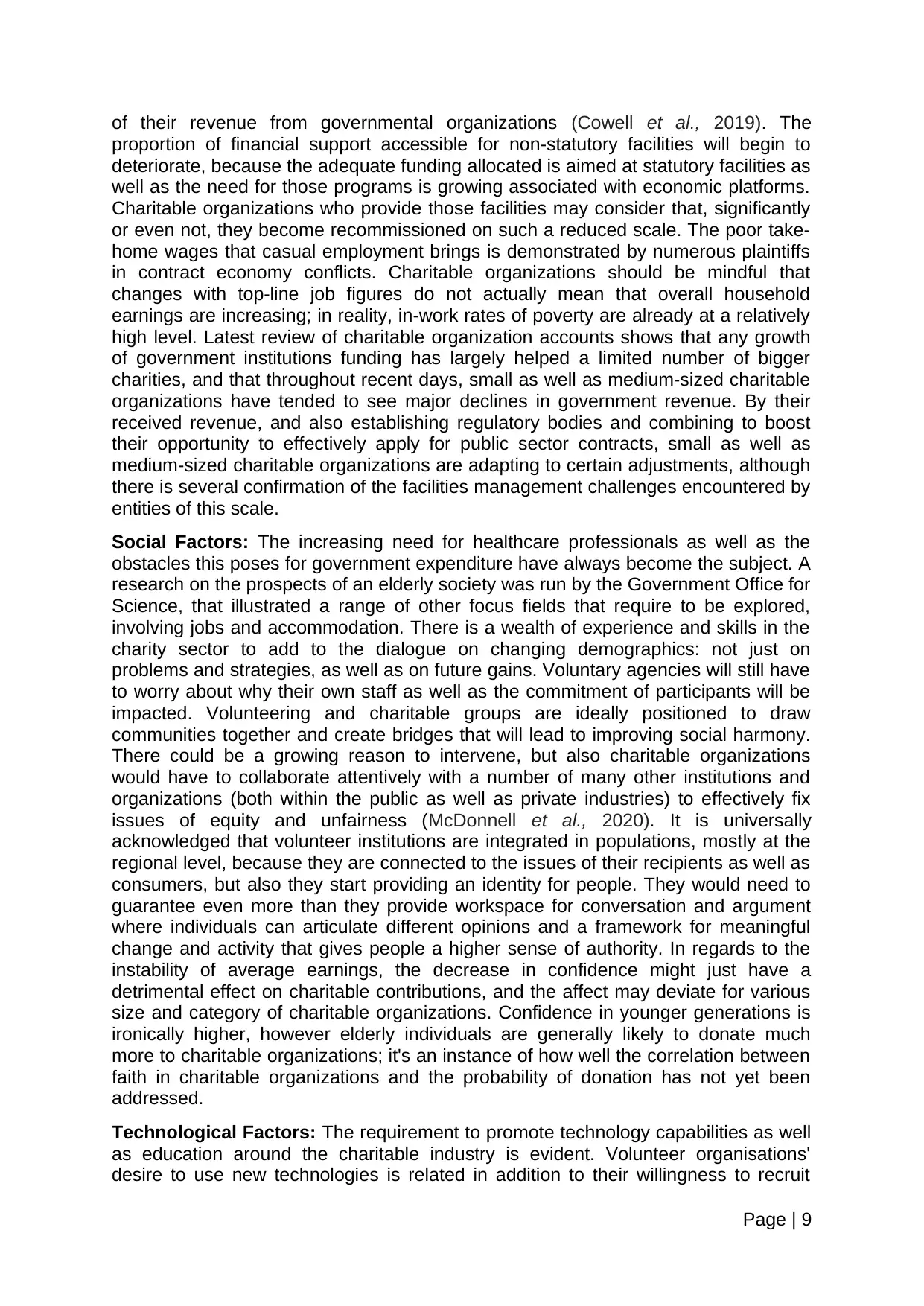
of their revenue from governmental organizations (Cowell et al., 2019). The
proportion of financial support accessible for non-statutory facilities will begin to
deteriorate, because the adequate funding allocated is aimed at statutory facilities as
well as the need for those programs is growing associated with economic platforms.
Charitable organizations who provide those facilities may consider that, significantly
or even not, they become recommissioned on such a reduced scale. The poor take-
home wages that casual employment brings is demonstrated by numerous plaintiffs
in contract economy conflicts. Charitable organizations should be mindful that
changes with top-line job figures do not actually mean that overall household
earnings are increasing; in reality, in-work rates of poverty are already at a relatively
high level. Latest review of charitable organization accounts shows that any growth
of government institutions funding has largely helped a limited number of bigger
charities, and that throughout recent days, small as well as medium-sized charitable
organizations have tended to see major declines in government revenue. By their
received revenue, and also establishing regulatory bodies and combining to boost
their opportunity to effectively apply for public sector contracts, small as well as
medium-sized charitable organizations are adapting to certain adjustments, although
there is several confirmation of the facilities management challenges encountered by
entities of this scale.
Social Factors: The increasing need for healthcare professionals as well as the
obstacles this poses for government expenditure have always become the subject. A
research on the prospects of an elderly society was run by the Government Office for
Science, that illustrated a range of other focus fields that require to be explored,
involving jobs and accommodation. There is a wealth of experience and skills in the
charity sector to add to the dialogue on changing demographics: not just on
problems and strategies, as well as on future gains. Voluntary agencies will still have
to worry about why their own staff as well as the commitment of participants will be
impacted. Volunteering and charitable groups are ideally positioned to draw
communities together and create bridges that will lead to improving social harmony.
There could be a growing reason to intervene, but also charitable organizations
would have to collaborate attentively with a number of many other institutions and
organizations (both within the public as well as private industries) to effectively fix
issues of equity and unfairness (McDonnell et al., 2020). It is universally
acknowledged that volunteer institutions are integrated in populations, mostly at the
regional level, because they are connected to the issues of their recipients as well as
consumers, but also they start providing an identity for people. They would need to
guarantee even more than they provide workspace for conversation and argument
where individuals can articulate different opinions and a framework for meaningful
change and activity that gives people a higher sense of authority. In regards to the
instability of average earnings, the decrease in confidence might just have a
detrimental effect on charitable contributions, and the affect may deviate for various
size and category of charitable organizations. Confidence in younger generations is
ironically higher, however elderly individuals are generally likely to donate much
more to charitable organizations; it's an instance of how well the correlation between
faith in charitable organizations and the probability of donation has not yet been
addressed.
Technological Factors: The requirement to promote technology capabilities as well
as education around the charitable industry is evident. Volunteer organisations'
desire to use new technologies is related in addition to their willingness to recruit
Page | 9
proportion of financial support accessible for non-statutory facilities will begin to
deteriorate, because the adequate funding allocated is aimed at statutory facilities as
well as the need for those programs is growing associated with economic platforms.
Charitable organizations who provide those facilities may consider that, significantly
or even not, they become recommissioned on such a reduced scale. The poor take-
home wages that casual employment brings is demonstrated by numerous plaintiffs
in contract economy conflicts. Charitable organizations should be mindful that
changes with top-line job figures do not actually mean that overall household
earnings are increasing; in reality, in-work rates of poverty are already at a relatively
high level. Latest review of charitable organization accounts shows that any growth
of government institutions funding has largely helped a limited number of bigger
charities, and that throughout recent days, small as well as medium-sized charitable
organizations have tended to see major declines in government revenue. By their
received revenue, and also establishing regulatory bodies and combining to boost
their opportunity to effectively apply for public sector contracts, small as well as
medium-sized charitable organizations are adapting to certain adjustments, although
there is several confirmation of the facilities management challenges encountered by
entities of this scale.
Social Factors: The increasing need for healthcare professionals as well as the
obstacles this poses for government expenditure have always become the subject. A
research on the prospects of an elderly society was run by the Government Office for
Science, that illustrated a range of other focus fields that require to be explored,
involving jobs and accommodation. There is a wealth of experience and skills in the
charity sector to add to the dialogue on changing demographics: not just on
problems and strategies, as well as on future gains. Voluntary agencies will still have
to worry about why their own staff as well as the commitment of participants will be
impacted. Volunteering and charitable groups are ideally positioned to draw
communities together and create bridges that will lead to improving social harmony.
There could be a growing reason to intervene, but also charitable organizations
would have to collaborate attentively with a number of many other institutions and
organizations (both within the public as well as private industries) to effectively fix
issues of equity and unfairness (McDonnell et al., 2020). It is universally
acknowledged that volunteer institutions are integrated in populations, mostly at the
regional level, because they are connected to the issues of their recipients as well as
consumers, but also they start providing an identity for people. They would need to
guarantee even more than they provide workspace for conversation and argument
where individuals can articulate different opinions and a framework for meaningful
change and activity that gives people a higher sense of authority. In regards to the
instability of average earnings, the decrease in confidence might just have a
detrimental effect on charitable contributions, and the affect may deviate for various
size and category of charitable organizations. Confidence in younger generations is
ironically higher, however elderly individuals are generally likely to donate much
more to charitable organizations; it's an instance of how well the correlation between
faith in charitable organizations and the probability of donation has not yet been
addressed.
Technological Factors: The requirement to promote technology capabilities as well
as education around the charitable industry is evident. Volunteer organisations'
desire to use new technologies is related in addition to their willingness to recruit
Page | 9
⊘ This is a preview!⊘
Do you want full access?
Subscribe today to unlock all pages.

Trusted by 1+ million students worldwide
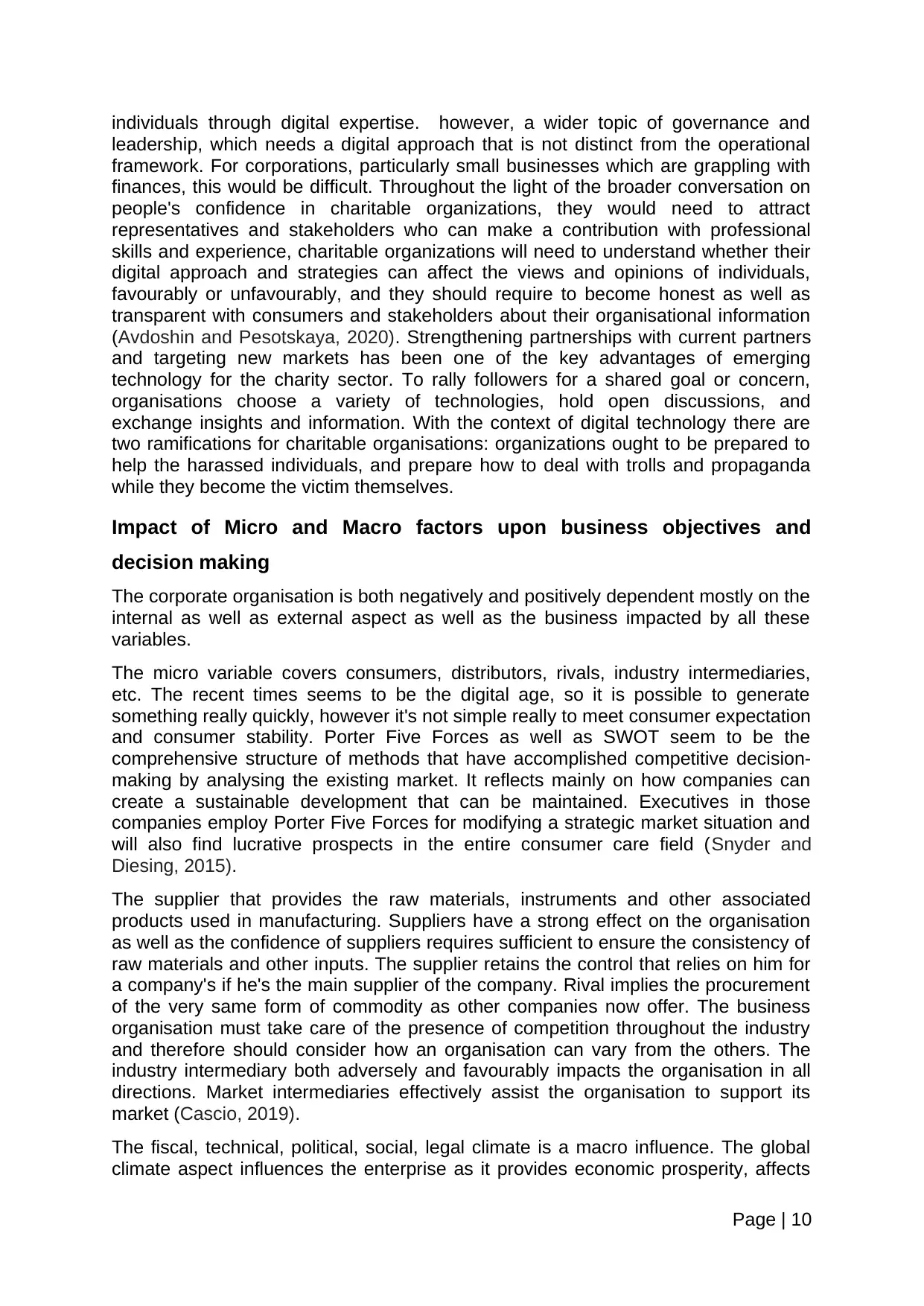
individuals through digital expertise. however, a wider topic of governance and
leadership, which needs a digital approach that is not distinct from the operational
framework. For corporations, particularly small businesses which are grappling with
finances, this would be difficult. Throughout the light of the broader conversation on
people's confidence in charitable organizations, they would need to attract
representatives and stakeholders who can make a contribution with professional
skills and experience, charitable organizations will need to understand whether their
digital approach and strategies can affect the views and opinions of individuals,
favourably or unfavourably, and they should require to become honest as well as
transparent with consumers and stakeholders about their organisational information
(Avdoshin and Pesotskaya, 2020). Strengthening partnerships with current partners
and targeting new markets has been one of the key advantages of emerging
technology for the charity sector. To rally followers for a shared goal or concern,
organisations choose a variety of technologies, hold open discussions, and
exchange insights and information. With the context of digital technology there are
two ramifications for charitable organisations: organizations ought to be prepared to
help the harassed individuals, and prepare how to deal with trolls and propaganda
while they become the victim themselves.
Impact of Micro and Macro factors upon business objectives and
decision making
The corporate organisation is both negatively and positively dependent mostly on the
internal as well as external aspect as well as the business impacted by all these
variables.
The micro variable covers consumers, distributors, rivals, industry intermediaries,
etc. The recent times seems to be the digital age, so it is possible to generate
something really quickly, however it's not simple really to meet consumer expectation
and consumer stability. Porter Five Forces as well as SWOT seem to be the
comprehensive structure of methods that have accomplished competitive decision-
making by analysing the existing market. It reflects mainly on how companies can
create a sustainable development that can be maintained. Executives in those
companies employ Porter Five Forces for modifying a strategic market situation and
will also find lucrative prospects in the entire consumer care field (Snyder and
Diesing, 2015).
The supplier that provides the raw materials, instruments and other associated
products used in manufacturing. Suppliers have a strong effect on the organisation
as well as the confidence of suppliers requires sufficient to ensure the consistency of
raw materials and other inputs. The supplier retains the control that relies on him for
a company's if he's the main supplier of the company. Rival implies the procurement
of the very same form of commodity as other companies now offer. The business
organisation must take care of the presence of competition throughout the industry
and therefore should consider how an organisation can vary from the others. The
industry intermediary both adversely and favourably impacts the organisation in all
directions. Market intermediaries effectively assist the organisation to support its
market (Cascio, 2019).
The fiscal, technical, political, social, legal climate is a macro influence. The global
climate aspect influences the enterprise as it provides economic prosperity, affects
Page | 10
leadership, which needs a digital approach that is not distinct from the operational
framework. For corporations, particularly small businesses which are grappling with
finances, this would be difficult. Throughout the light of the broader conversation on
people's confidence in charitable organizations, they would need to attract
representatives and stakeholders who can make a contribution with professional
skills and experience, charitable organizations will need to understand whether their
digital approach and strategies can affect the views and opinions of individuals,
favourably or unfavourably, and they should require to become honest as well as
transparent with consumers and stakeholders about their organisational information
(Avdoshin and Pesotskaya, 2020). Strengthening partnerships with current partners
and targeting new markets has been one of the key advantages of emerging
technology for the charity sector. To rally followers for a shared goal or concern,
organisations choose a variety of technologies, hold open discussions, and
exchange insights and information. With the context of digital technology there are
two ramifications for charitable organisations: organizations ought to be prepared to
help the harassed individuals, and prepare how to deal with trolls and propaganda
while they become the victim themselves.
Impact of Micro and Macro factors upon business objectives and
decision making
The corporate organisation is both negatively and positively dependent mostly on the
internal as well as external aspect as well as the business impacted by all these
variables.
The micro variable covers consumers, distributors, rivals, industry intermediaries,
etc. The recent times seems to be the digital age, so it is possible to generate
something really quickly, however it's not simple really to meet consumer expectation
and consumer stability. Porter Five Forces as well as SWOT seem to be the
comprehensive structure of methods that have accomplished competitive decision-
making by analysing the existing market. It reflects mainly on how companies can
create a sustainable development that can be maintained. Executives in those
companies employ Porter Five Forces for modifying a strategic market situation and
will also find lucrative prospects in the entire consumer care field (Snyder and
Diesing, 2015).
The supplier that provides the raw materials, instruments and other associated
products used in manufacturing. Suppliers have a strong effect on the organisation
as well as the confidence of suppliers requires sufficient to ensure the consistency of
raw materials and other inputs. The supplier retains the control that relies on him for
a company's if he's the main supplier of the company. Rival implies the procurement
of the very same form of commodity as other companies now offer. The business
organisation must take care of the presence of competition throughout the industry
and therefore should consider how an organisation can vary from the others. The
industry intermediary both adversely and favourably impacts the organisation in all
directions. Market intermediaries effectively assist the organisation to support its
market (Cascio, 2019).
The fiscal, technical, political, social, legal climate is a macro influence. The global
climate aspect influences the enterprise as it provides economic prosperity, affects
Page | 10
Paraphrase This Document
Need a fresh take? Get an instant paraphrase of this document with our AI Paraphraser
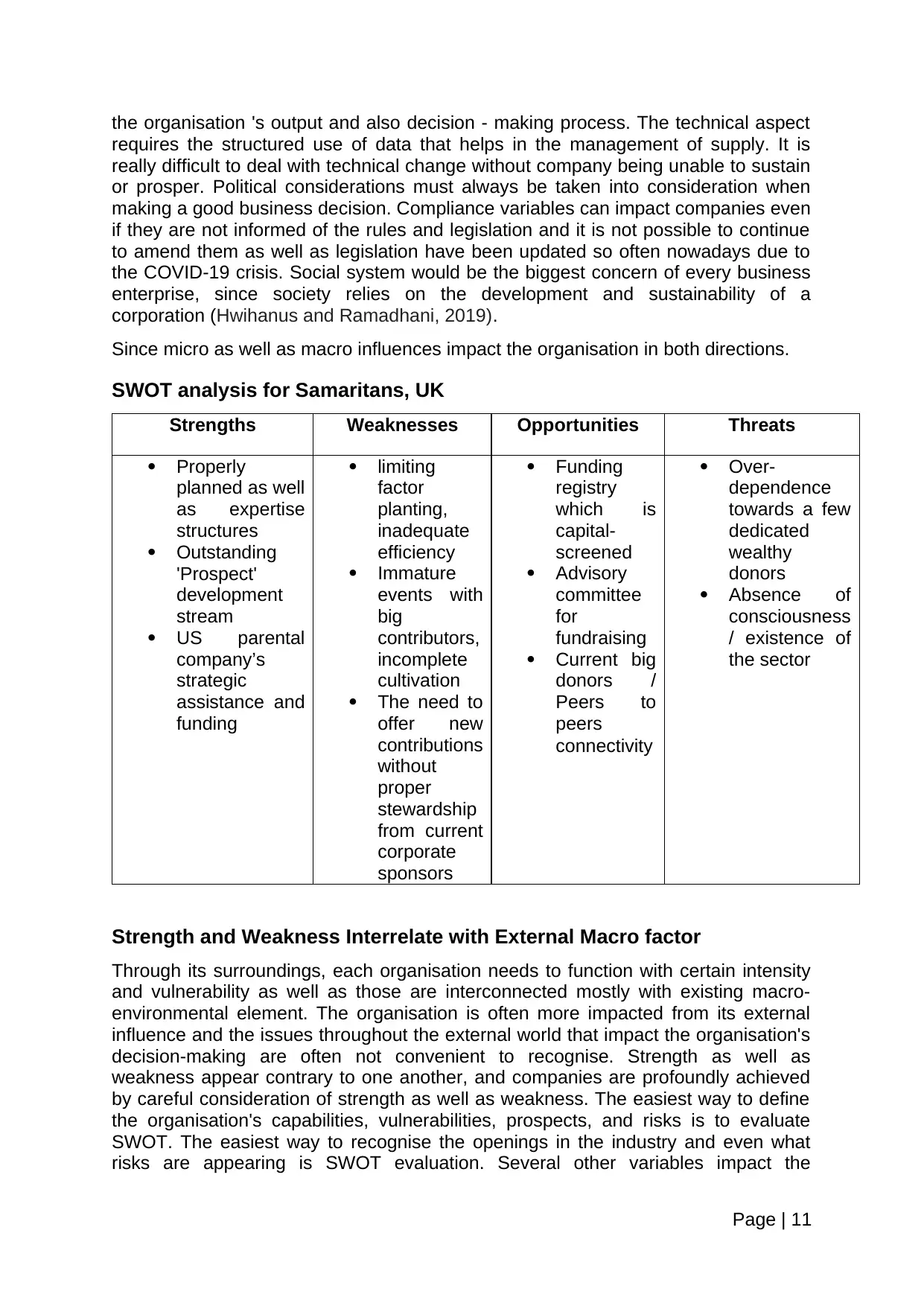
the organisation 's output and also decision - making process. The technical aspect
requires the structured use of data that helps in the management of supply. It is
really difficult to deal with technical change without company being unable to sustain
or prosper. Political considerations must always be taken into consideration when
making a good business decision. Compliance variables can impact companies even
if they are not informed of the rules and legislation and it is not possible to continue
to amend them as well as legislation have been updated so often nowadays due to
the COVID-19 crisis. Social system would be the biggest concern of every business
enterprise, since society relies on the development and sustainability of a
corporation (Hwihanus and Ramadhani, 2019).
Since micro as well as macro influences impact the organisation in both directions.
SWOT analysis for Samaritans, UK
Strengths Weaknesses Opportunities Threats
Properly
planned as well
as expertise
structures
Outstanding
'Prospect'
development
stream
US parental
company’s
strategic
assistance and
funding
limiting
factor
planting,
inadequate
efficiency
Immature
events with
big
contributors,
incomplete
cultivation
The need to
offer new
contributions
without
proper
stewardship
from current
corporate
sponsors
Funding
registry
which is
capital-
screened
Advisory
committee
for
fundraising
Current big
donors /
Peers to
peers
connectivity
Over-
dependence
towards a few
dedicated
wealthy
donors
Absence of
consciousness
/ existence of
the sector
Strength and Weakness Interrelate with External Macro factor
Through its surroundings, each organisation needs to function with certain intensity
and vulnerability as well as those are interconnected mostly with existing macro-
environmental element. The organisation is often more impacted from its external
influence and the issues throughout the external world that impact the organisation's
decision-making are often not convenient to recognise. Strength as well as
weakness appear contrary to one another, and companies are profoundly achieved
by careful consideration of strength as well as weakness. The easiest way to define
the organisation's capabilities, vulnerabilities, prospects, and risks is to evaluate
SWOT. The easiest way to recognise the openings in the industry and even what
risks are appearing is SWOT evaluation. Several other variables impact the
Page | 11
requires the structured use of data that helps in the management of supply. It is
really difficult to deal with technical change without company being unable to sustain
or prosper. Political considerations must always be taken into consideration when
making a good business decision. Compliance variables can impact companies even
if they are not informed of the rules and legislation and it is not possible to continue
to amend them as well as legislation have been updated so often nowadays due to
the COVID-19 crisis. Social system would be the biggest concern of every business
enterprise, since society relies on the development and sustainability of a
corporation (Hwihanus and Ramadhani, 2019).
Since micro as well as macro influences impact the organisation in both directions.
SWOT analysis for Samaritans, UK
Strengths Weaknesses Opportunities Threats
Properly
planned as well
as expertise
structures
Outstanding
'Prospect'
development
stream
US parental
company’s
strategic
assistance and
funding
limiting
factor
planting,
inadequate
efficiency
Immature
events with
big
contributors,
incomplete
cultivation
The need to
offer new
contributions
without
proper
stewardship
from current
corporate
sponsors
Funding
registry
which is
capital-
screened
Advisory
committee
for
fundraising
Current big
donors /
Peers to
peers
connectivity
Over-
dependence
towards a few
dedicated
wealthy
donors
Absence of
consciousness
/ existence of
the sector
Strength and Weakness Interrelate with External Macro factor
Through its surroundings, each organisation needs to function with certain intensity
and vulnerability as well as those are interconnected mostly with existing macro-
environmental element. The organisation is often more impacted from its external
influence and the issues throughout the external world that impact the organisation's
decision-making are often not convenient to recognise. Strength as well as
weakness appear contrary to one another, and companies are profoundly achieved
by careful consideration of strength as well as weakness. The easiest way to define
the organisation's capabilities, vulnerabilities, prospects, and risks is to evaluate
SWOT. The easiest way to recognise the openings in the industry and even what
risks are appearing is SWOT evaluation. Several other variables impact the
Page | 11
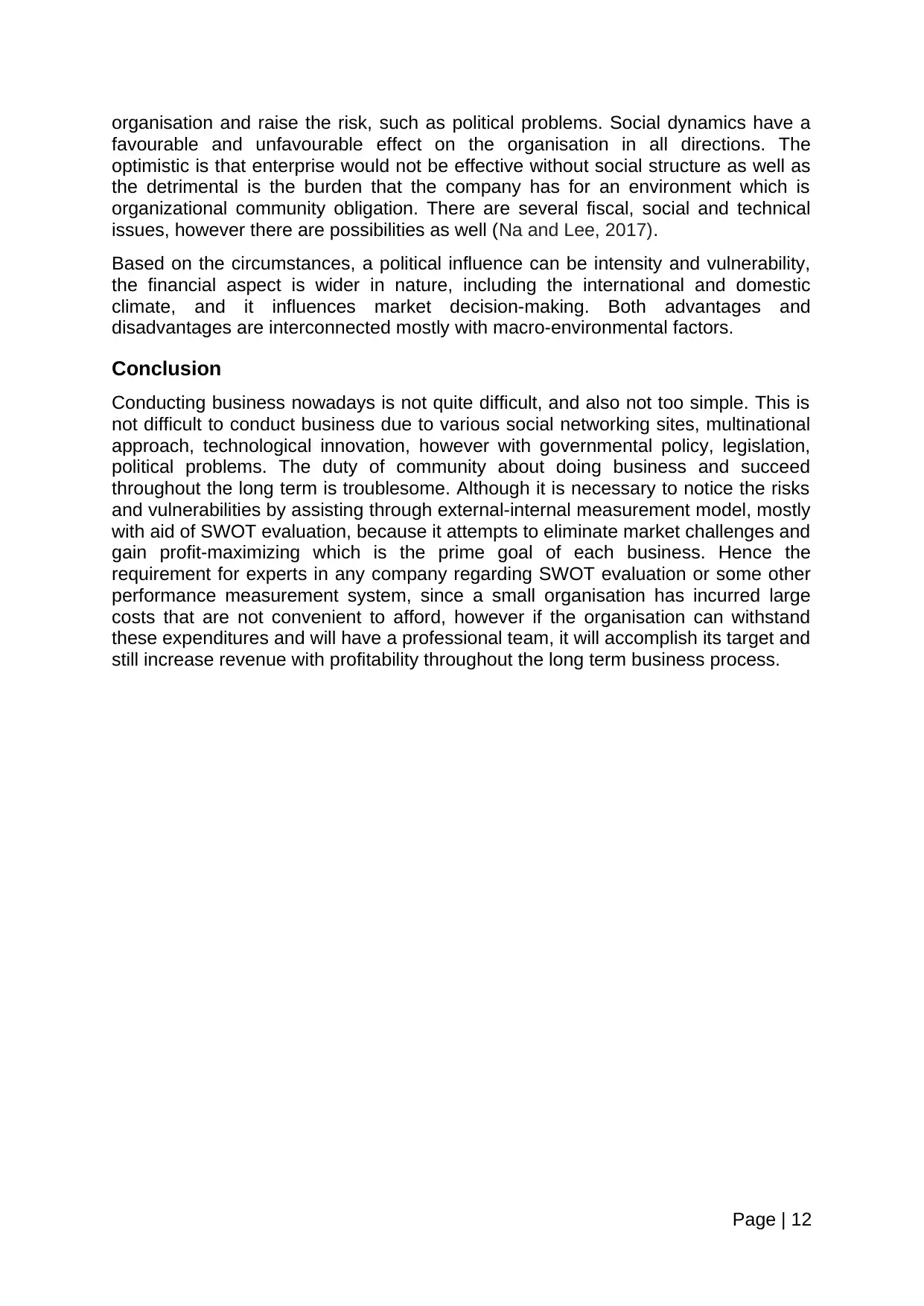
organisation and raise the risk, such as political problems. Social dynamics have a
favourable and unfavourable effect on the organisation in all directions. The
optimistic is that enterprise would not be effective without social structure as well as
the detrimental is the burden that the company has for an environment which is
organizational community obligation. There are several fiscal, social and technical
issues, however there are possibilities as well (Na and Lee, 2017).
Based on the circumstances, a political influence can be intensity and vulnerability,
the financial aspect is wider in nature, including the international and domestic
climate, and it influences market decision-making. Both advantages and
disadvantages are interconnected mostly with macro-environmental factors.
Conclusion
Conducting business nowadays is not quite difficult, and also not too simple. This is
not difficult to conduct business due to various social networking sites, multinational
approach, technological innovation, however with governmental policy, legislation,
political problems. The duty of community about doing business and succeed
throughout the long term is troublesome. Although it is necessary to notice the risks
and vulnerabilities by assisting through external-internal measurement model, mostly
with aid of SWOT evaluation, because it attempts to eliminate market challenges and
gain profit-maximizing which is the prime goal of each business. Hence the
requirement for experts in any company regarding SWOT evaluation or some other
performance measurement system, since a small organisation has incurred large
costs that are not convenient to afford, however if the organisation can withstand
these expenditures and will have a professional team, it will accomplish its target and
still increase revenue with profitability throughout the long term business process.
Page | 12
favourable and unfavourable effect on the organisation in all directions. The
optimistic is that enterprise would not be effective without social structure as well as
the detrimental is the burden that the company has for an environment which is
organizational community obligation. There are several fiscal, social and technical
issues, however there are possibilities as well (Na and Lee, 2017).
Based on the circumstances, a political influence can be intensity and vulnerability,
the financial aspect is wider in nature, including the international and domestic
climate, and it influences market decision-making. Both advantages and
disadvantages are interconnected mostly with macro-environmental factors.
Conclusion
Conducting business nowadays is not quite difficult, and also not too simple. This is
not difficult to conduct business due to various social networking sites, multinational
approach, technological innovation, however with governmental policy, legislation,
political problems. The duty of community about doing business and succeed
throughout the long term is troublesome. Although it is necessary to notice the risks
and vulnerabilities by assisting through external-internal measurement model, mostly
with aid of SWOT evaluation, because it attempts to eliminate market challenges and
gain profit-maximizing which is the prime goal of each business. Hence the
requirement for experts in any company regarding SWOT evaluation or some other
performance measurement system, since a small organisation has incurred large
costs that are not convenient to afford, however if the organisation can withstand
these expenditures and will have a professional team, it will accomplish its target and
still increase revenue with profitability throughout the long term business process.
Page | 12
⊘ This is a preview!⊘
Do you want full access?
Subscribe today to unlock all pages.

Trusted by 1+ million students worldwide
1 out of 14
Related Documents
Your All-in-One AI-Powered Toolkit for Academic Success.
+13062052269
info@desklib.com
Available 24*7 on WhatsApp / Email
![[object Object]](/_next/static/media/star-bottom.7253800d.svg)
Unlock your academic potential
Copyright © 2020–2025 A2Z Services. All Rights Reserved. Developed and managed by ZUCOL.





